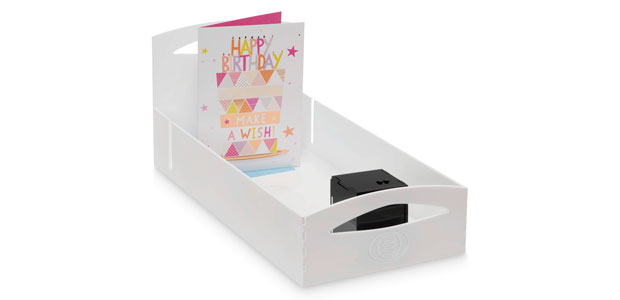
The Owlett - a camera to help the visually impaired around the house
There are a lot of things that we take for granted. Something as simple as reading the label on the ingredients for dinner is quick and easy; but not for everyone. For all the wonderful things making our lives easier, there is still a lack of tech out there which effectively assists blind people in everyday tasks, such as reading text. Billy Wood, Founder of Owlett, has set out to change this.

How did The Owlett get started?
In order to help my mum around the house, she’s blind, I built a small box that can describe anything placed in front of it. She’s a keen lover of technology to help with her disability and after speaking to her about what I could do to help, she asked for help around the kitchen, identifying what is in cans, tins and bottles.
From there I started working with a company in California, which does image recognition for large companies I was able to put together a hardware prototype. She’s been using it and various other prototypes for well over a year. I’ve been trialling it with multiple user groups and with the help of some local charities I’ve been able to put together a good prototype, that I am hoping to be able to take to market in the near future.
The biggest issue that I’ve had is working on a shoestring budget, this has been a passion project for me. The first prototype was built April last year and I’ve been steadily trying to put together resources and making use of Makerspace, I’ve been trying to hack together as much as I can with no budget and no funding.
Have you tried to get funding?
Yes, but I haven’t had much luck. I am applying for innovate grants but haven’t had any success so far with the grants that are available. Angel investors don’t seem like they will be interested until I am able to really start selling and have something that’s already out there. So I’ve been trying to bootstrap it as much as possible and I am hoping that the trials coming up soon will help to validate the idea enough to get the investment I need to bring it to market.
I’ve managed so far because I’ve made good use of prototyping hardware, the original designs were based on Raspberry Pi’s and eventually I was able to spin off of that into custom PCB designs. I’m also a member of a local Makerspace, which was a really useful resource for me to get hold of the 3D printing and laser cutting I needed to do some rapid prototyping. Also contacting local charities and user groups has been a fantastic resource for me to validate the ideas that I’m working on, and to make sure that I’m going in the right direction.
What can you tell us about your product design?
It’s designed as a standalone product, it doesn’t connect to an app on a phone or anything like that, it is just a small box which is either placed statically on a table or is handheld and carried around by the user, and you put something in front of it, or push a button on it and then it takes a picture of it, sends that to a cloud algorithm, which is then able to come back with a human-understandable description. So if you put a tin of beans in front of it, after a couple of seconds it would come back and tell you that it is a tin of baked beans, it’s flavour, colour and read any text on the object.
It’s using Google’s text reading algorithm, which is good at reading text even if it’s upside-down or on its side. It’s using a well-established object recognition algorithm, which is designed to detect brands. In general it does better with branded goods with anything else. The biggest limitation it has is that it has to connect with the internet to work.
I also went through a series of small trials with charities and user groups, as well as my mum, which lead me to changes in a couple of prototypes. The original design was very different to what I have now, it was originally going to be using voice for the user to interact with. The user would ask the device to describe what was in front of it, but the early feedback was that it added an extra step to a process that wasn’t needed and made it inconvenient. By trialling it with blind users I was able to make the changes needed to make it into something that would actually be useful.
Do you think your startup has the potential to change the way people live their lives?
I think so yes. There are 360,000 blind people in the UK, seven million in the US, many many more internationally, and right now there is no device which really helps them. There are phone apps which so something similar, but they are only usable for people who are able to use a phone, which is difficult if you are elderly or completely blind. There are head mounted devices which besides from being prohibitively expensive, also require you to point a device at something or to put something in front of your head, which can be difficult if you are completely blind. I believe I have created something which is usable for a disability which otherwise doesn’t have much that can help them.
What’s next for The Owlett?
I’ve got the next prototype together, which I’m hoping to be able to take to long term trial by the end of the month. I already have a number of volunteers that I have met by hosting stands at different tech events for disabled technology and technology for the blind, and they will be taking the device for about a month, and coming back with some feedback and getting testimonies, which I am hoping will lead into a full release down the road.

